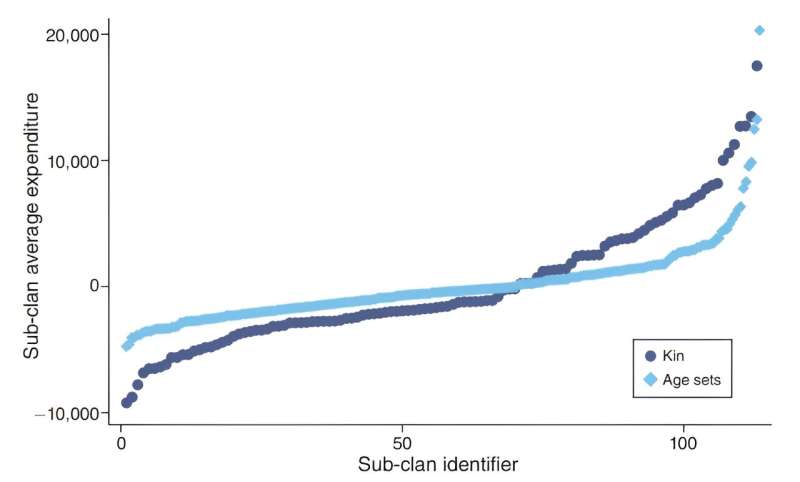People around the globe often depend on informal financial arrangements, borrowing and lending money through social networks. Understanding this sheds light on local economies and helps fight poverty.
Now, a study co-authored by an MIT economist illuminates a striking case of informal finance: In East Africa, money moves in very different patterns depending on whether local societies are structured around family units or age-based groups.
That is, while much of the world uses the extended family as a basic social unit, hundreds of millions of people live in societies with stronger age-based cohorts. In these cases, people are initiated into adulthood together and maintain closer social ties with each other than with extended family. That affects their finances, too.
“We found there are major impacts in that social structure really does matter for how people form financial ties,” says Jacob Moscona, an MIT economist and co-author of the newly published study.
He adds, “In age-based societies when someone gets a cash transfer, the money flows in a big way to other members of their age cohort but not to other [younger or older] members of an extended family. And you see the exact opposite pattern in kin-based groups, where money is transferred within the family but not the age cohort.”
This leads to measurable health effects. In kin-based societies, grandparents often share their pension payments with grandchildren. In Uganda, the study reveals, an additional year of pension payments to a senior citizen in a kin-based society reduces the likelihood of child malnourishment by 5.5%, compared to an age-based society where payments are less likely to move across generations.
The paper, “Age Set versus Kin: Culture and Financial Ties in East Africa,” is published in the September issue of the American Economic Review. The authors are Moscona, the 3M Career Development Assistant Professor of Economics in MIT’s Department of Economics; and Awa Ambra Seck, an assistant professor at Harvard Business School.
Studying informal financial arrangements has long been an important research domain for economists. MIT Professor Robert Townsend, for one, helped advance this area of scholarship with innovative studies of finances in rural Thailand.
At the same time, the specific matter of analyzing how age-based social groups function, in comparison to the more common kin-based groups, has tended to be addressed more by anthropologists than economists.
Among the Maasai people in Northern Kenya, for example, anthropologists have observed that age-group friends have closer ties to each other than anyone apart from a spouse and children. Maasai age-group cohorts frequently share food and lodging, and more extensively than they do even with siblings. The current study adds economic data points to this body of knowledge.
To conduct the research, the scholars first analyzed the Kenyan government’s Hunger Safety Net Program (HSNP), a cash transfer project initiated in 2009 covering 48 locations in Northern Kenya. The program included both age-based and kin-based social groups, allowing for a comparison of its effects.
In age-based societies, the study shows, there was a spillover in spending by HSNP recipients on others in the age cohort, with zero additional cash flows to those in other generations; in kin-based societies, they also found a spillover across generations, but without informal cash flows otherwise.
In Uganda, where both kin-based and age-based societies exist, the researchers studied the national roll-out of the Senior Citizen Grant (SCG) program, initiated in 2011, which consists of a monthly cash transfer to seniors of about $7.50, equivalent to roughly 20% of per-capita spending. Similar programs exist or are being rolled out across sub-Saharan Africa, including in regions where age-based organization is common.
Here again, the researchers found financial flows aligned to kin-based and age-based social ties. In particular, they show that the pension program had large positive effects on child nutrition in kin-based households, where ties across generations are strong; the team found zero evidence of these effects in age-based societies.
“These policies had vastly different effects on these two groups, on account of the very different structure of financial ties,” Moscona says.
To Moscona, there are at least two large reasons to evaluate the variation between these financial flows: understanding society more thoroughly and rethinking how to design social programs in these circumstances.
“It’s telling us something about how the world works, that social structure is really important for shaping these [financial] relationships,” Moscona says. “But it also has a big potential impact on policy.”
After all, if a social policy is designed to help limit childhood poverty, or senior poverty, experts will want to know how the informal flow of cash in a society interacts with it. The current study shows that understanding social structure should be a high-order concern for making policies more effective.
“In these two ways of organizing society, different people are on average more vulnerable,” Moscona says. “In the kin-based groups, because the young and the old share with each other, you don’t see as much inequality across generations.
“But in age-based groups, the young and the old are left systematically more vulnerable. And in kin-based groups, some entire families are doing much worse than others, while in age-based societies the age sets often cut across lineages or extended families, making them more equal. That’s worth considering if you’re thinking about poverty reduction.”
More information:
Jacob Moscona et al, Age Set versus Kin: Culture and Financial Ties in east Africa, American Economic Review (2024). DOI: 10.1257/aer.20211856
Provided by
Massachusetts Institute of Technology
This story is republished courtesy of MIT News (web.mit.edu/newsoffice/), a popular site that covers news about MIT research, innovation and teaching.
Citation:
How social structure influences the way people share money (2024, September 26)
retrieved 27 September 2024
from https://phys.org/news/2024-09-social-people-money.html
This document is subject to copyright. Apart from any fair dealing for the purpose of private study or research, no
part may be reproduced without the written permission. The content is provided for information purposes only.

